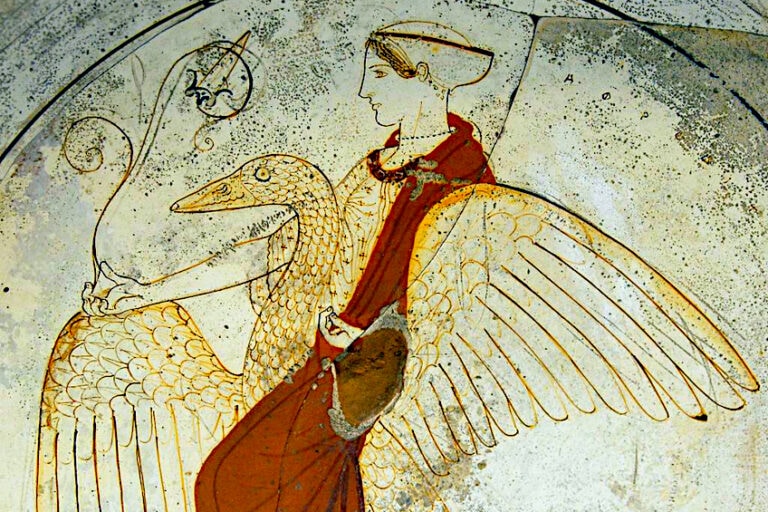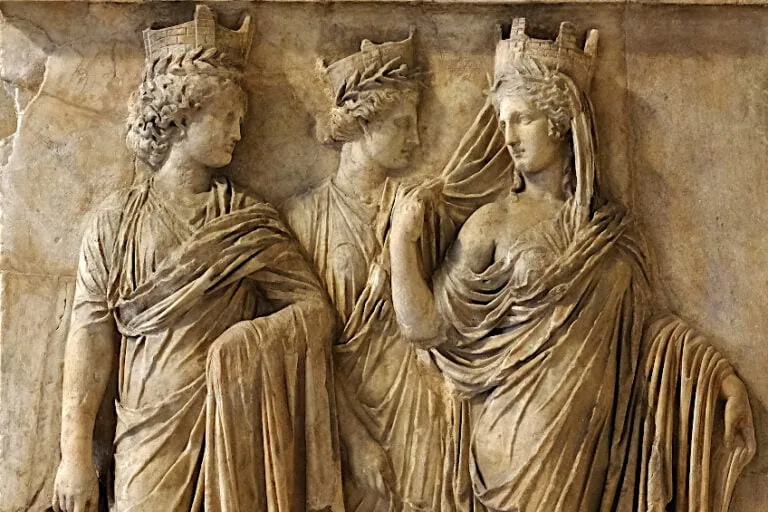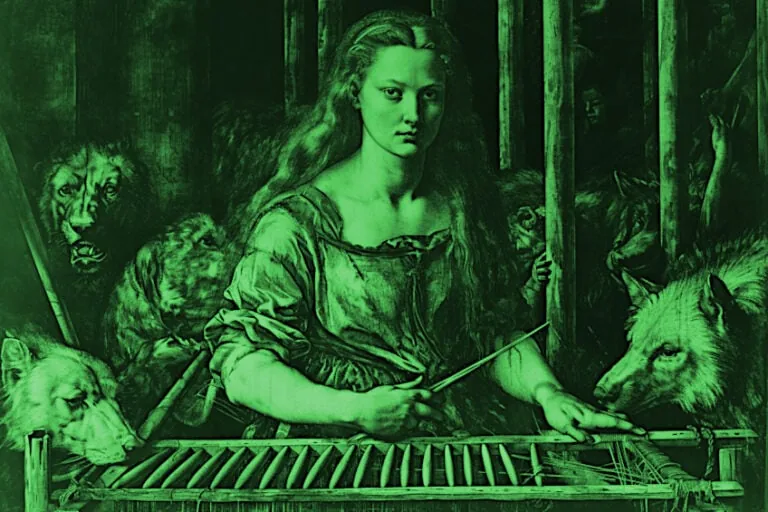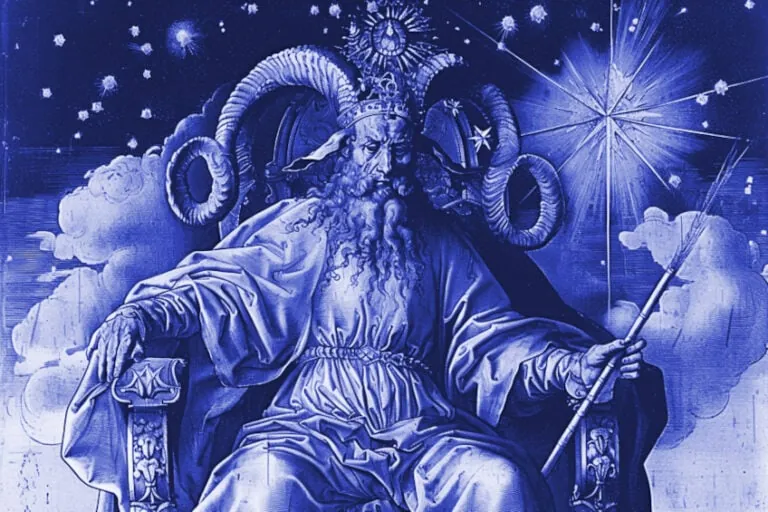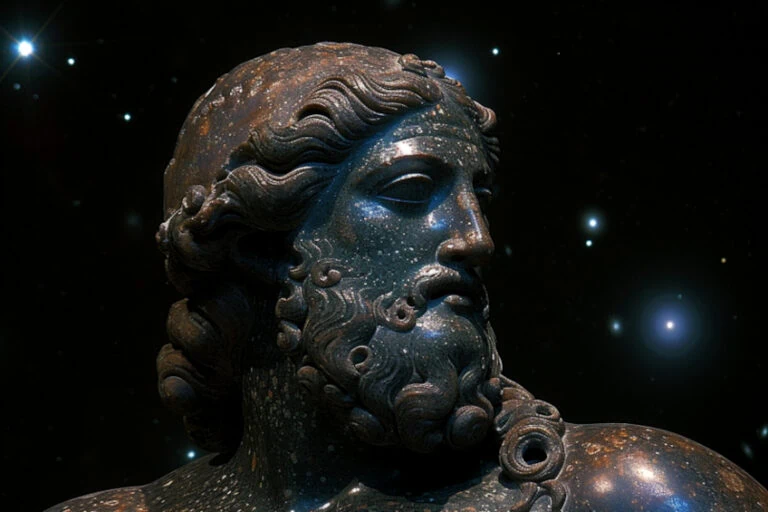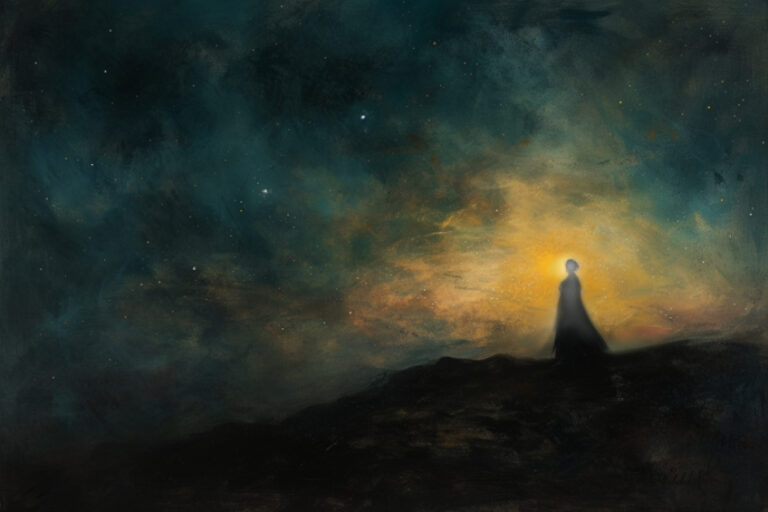Greek Goddess Gaia – Earthly Mother of Gods and Monsters
What is Gaia the god of? Gaia was the ancient Greeks’ primordial goddess of Earth. In modern usage, her name has come to serve as the embodiment of the planet itself. In Gaia mythology, she represents the ancestral mother of all divine life. Let’s find out more about the Greek goddess Gaia, and answer your questions like, “What does Gaia look like?”, and “Is Gaia a Titan?”.
The Significance of the Greek Goddess Gaia
| Name | Gaia |
| Gender | Female |
| Symbols | Fruit, grain, and Earth |
| Personality | Protective and generous |
| Domains | The Earth |
| Parents | None |
| Spouse/Consorts | Uranus, Pontus, Aether, and Tartarus |
| Children | Uranus, Pontus, the Ourea, the Hecatonchires, the Cyclopes, the Titans, the Gigantes, Nereus, Thaumus, Phorcys, Ceto, Eurybia, Aergia, Typhon, Python, and Antaeus |
Is Gaia a Titan? No, Gaia is regarded as a primordial god – one of the first ancient deities that came into existence at the beginning of the Greek creation story. She and Uranus were the parents of the race of gods whose rebellion against their father’s cruelty resulted in him naming them Titans.
 Gaia suckling an infant (1st Century); Walters Art Museum, Public domain, via Wikimedia Commons
Gaia suckling an infant (1st Century); Walters Art Museum, Public domain, via Wikimedia Commons
The role of Gaia in Greek mythology is at times conflicting or startling. Enraged by Uranus’ insistence on pushing the children she bore him back into her womb, Gaia asked her children to rebel against their father. Her son Cronus agreed and castrated his father with a sickle provided by Gaia. When Cronus in turn proved as wicked as Uranus by eating his own children, Gaia assisted her daughter Rhea by helping her hide and raise the infant Zeus so that he could overthrow his father’s oppressive rule.
When Zeus displeased her by imprisoning the Titans and killing the Giants, Gaia and Tartarus produced the greatest threat to the new Olympian order, a monster called Typhon who held the new gods at bay until Zeus could finally defeat him.
Background and Family
Gaia’s origins are detailed in the cosmogonic tale recounted in Hesiod’s Theogony. The Greek goddess Gaia is one of the first entities to emerge from Chaos, a formless vacuum that represents the previous state of the cosmos before creation. Gaia is the earliest tangible entity, representing the actual Earth itself.
Gaia, the solid foundation beneath the skies, spontaneously formed from Chaos, according to Gaia mythology.
She subsequently gave birth to Uranus in the absence of a partner, and they became the first divine pair. Gaia and Uranus later gave birth to a slew of formidable creatures, including the Cyclopes, Titans, Giants, and the Hecatoncheires.
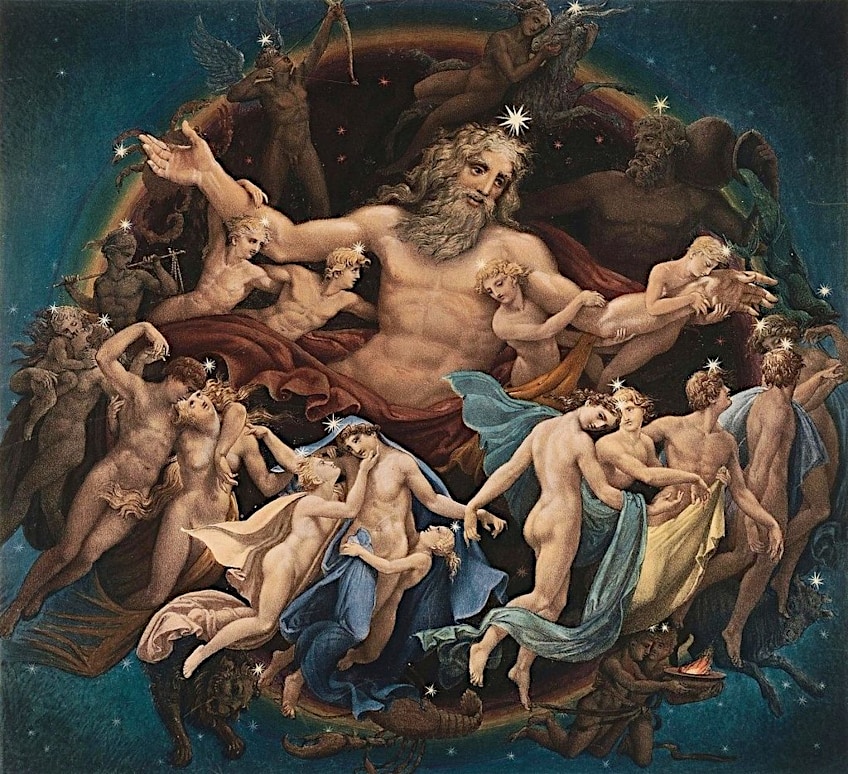 Uranus and the Dance of the Stars by Karl Friedrich Schinkel (1834); Karl Friedrich Schinkel, Public domain, via Wikimedia Commons
Uranus and the Dance of the Stars by Karl Friedrich Schinkel (1834); Karl Friedrich Schinkel, Public domain, via Wikimedia Commons
The Offspring of Gaia
Uranus was Gaia’s son and spouse, as well as the personification of the sky. They become the parents of many divine beings. The most famous were the sons and daughters who would later be named the 12 Titans. Hesiod named them as Coeus, Oceanus, Crius, Iapetus, Hyperion, Rhea, Theia, Mnemosyne, Themis, Phoebe, Tethys, and Cronus.
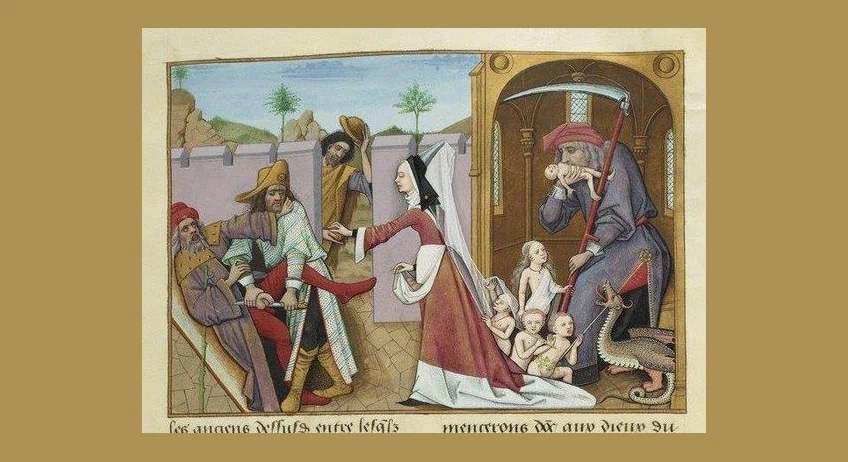 Illuminated manuscript showing Gaia’s family. She stand between Uranus being castrated and Cronus devouring his children (c. 1401); Robinet Testard, Public domain, via Wikimedia Commons
Illuminated manuscript showing Gaia’s family. She stand between Uranus being castrated and Cronus devouring his children (c. 1401); Robinet Testard, Public domain, via Wikimedia Commons
Other children of Gaia and Uranus included the Cyclopes, who were giants with one eye. Steropes, Brontes, and Arges were the three most renowned Cyclopes. They were skillful artisans who made numerous formidable weapons for Zeus and the other gods. Gaia and Uranus were also the parents of the Hecatoncheires, who were massive beings with 50 heads and 100 arms. They were named Cottus, Briareus, and Gyges.
Other Consorts and Children
Apart from Uranus, Gaia, the Greek goddess of Earth, had other consorts in Greek mythology. Pontus was the embodiment of the sea and a primordial sea god. Gaia and Pontus gave birth to sea deities known as sea nymphs. Tartarus represented the deep abyss, a dark and foreboding location under the underworld. Many terrible monsters, including the Giants and the Typhon, were claimed to have been born to Gaia and Tartarus.
Aether was the embodiment of the air of the heavens. Gaia and Aether were also represented as consorts on occasion.
The Role of the Greek Goddess Gaia
Gaia personified the Earth. She was linked to the soil in all its manifestations and revered as the mother of all living things. Gaia’s function as a mother figure represented fertility, creation, and nature’s generative processes. Gaia was regarded as a protecting and caring deity. She gave food and plenty to the Earth, supervising plant growth, soil fertility, and the well-being of all living animals.
Gaia was one of the Greeks’ most important Chthonic gods, associated with fertility as well as the Underworld. The most distinguishing feature of Chthonic rituals was that the animals offered had to be black in color. Gaia played important roles in various rituals and was called upon to protected oaths in everyday life.
The mythological monarch Erichthonius of Athens is reported to have ordered that Gaia Kourotrophos receive a pre-sacrifice before any other sacrifice. During severe droughts, Gaia was sometimes referred to as Ge Karpophoros. Gaia was linked to oracles and prophecy. The vapors that inspired such oracles as the Pythia in Delphi originated from the earth’s bowels, and therefore from Gaia herself. The sacred precinct of Apollo at Delphi, the most renowned of all Greek oracles, was considered to have initially belonged to the Greek goddess Gaia. Gaia had temples, shrines, and altars all across Greece, including Sparta, Athens, Tegea, and Olympia.
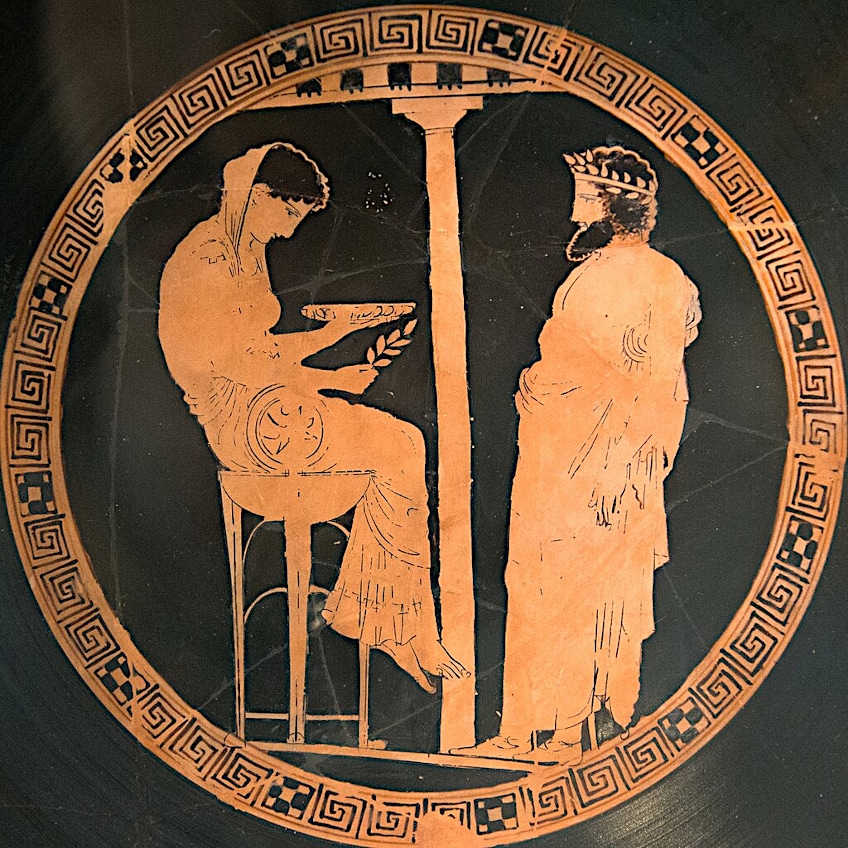 Attic red-figure kylix depiciting the Delphic oracle (440-430 BCE); Zde, CC BY-SA 4.0, via Wikimedia Commons
Attic red-figure kylix depiciting the Delphic oracle (440-430 BCE); Zde, CC BY-SA 4.0, via Wikimedia Commons
Gaia was worshiped alongside Demeter, the goddess of agriculture and therefore another earth mother, in some areas, such as the city of Patrae in central Greece. There were also supposed to be countless cult sculptures of Gaia, some of which were exceedingly old. However, none of these have survived, and we know very little about how they could have appeared.
Gaia was worshiped as the goddess Tellus in Rome. Around 304 BCE, a Tellus temple was erected near an important thoroughfare in Rome. Tellus’ celebration, known as the Fordicidia, was celebrated every April and included animal sacrifice.
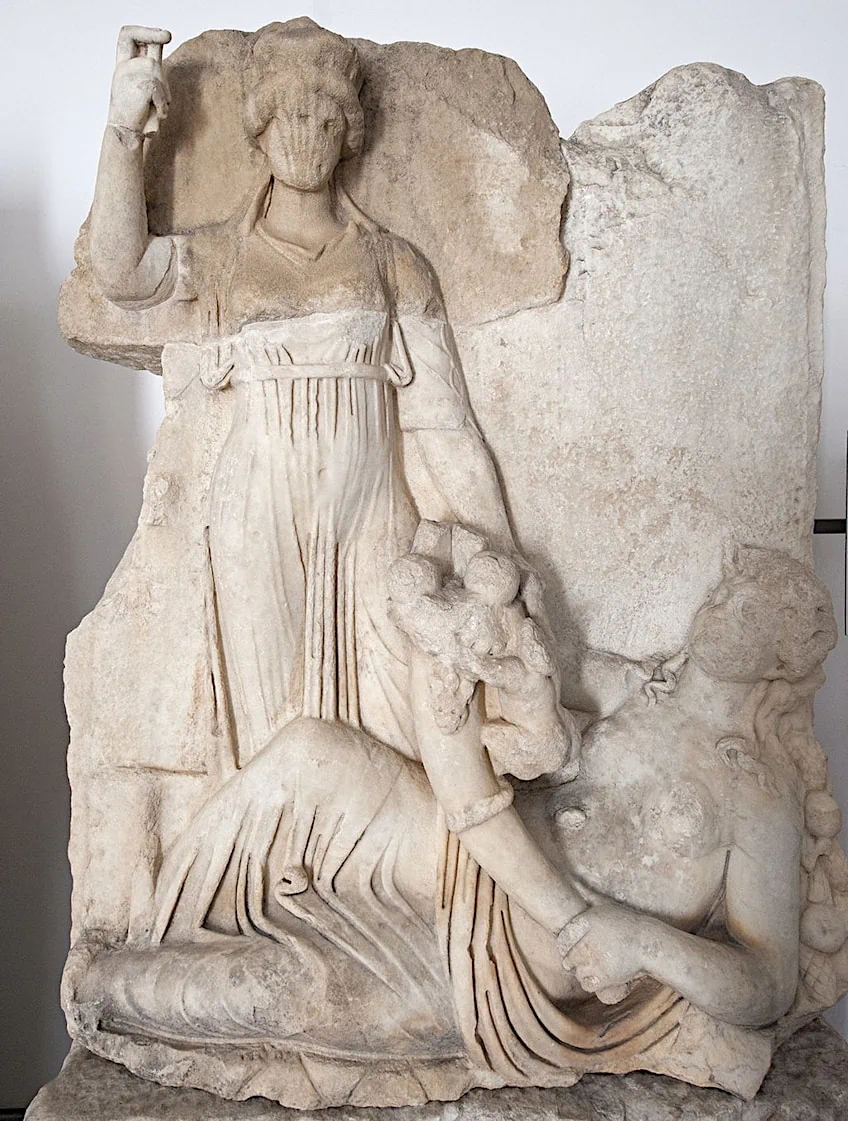 Relief showing Roma the mythical ancestress of Rome and Tellus-Gaia (1st Century CE); Dosseman, CC BY-SA 4.0, via Wikimedia Commons
Relief showing Roma the mythical ancestress of Rome and Tellus-Gaia (1st Century CE); Dosseman, CC BY-SA 4.0, via Wikimedia Commons
Personality and Attributes of Gaia
Gaia controlled crop fertility and protected children and all forms of new life. Gaia was not frequently shown in ancient art, but when she was, her relationship to the earth was highlighted. What does Gaia look like, though? Gaia was represented in ancient Greek art as a matronly figure, seated or standing, bearing qualities linked with the Earth, such as flowers, fruits, or grains. She often appeared with animals around her, demonstrating her closeness to nature.
Gaia sculptures were erected across ancient Greece, but the majority of them have not endured to the present day.
Some of the few surviving sculptures show Gaia as a strong and regal figure, stressing her position as Earth Mother. Images of Gaia can be found in antique mosaics and frescoes. These paintings frequently represented her as a calm and maternal figure, sitting or reclining, with the Earth as a backdrop. Modern images of Gaia retain her attributes as fertile, monumental, and closely connected to the ground.
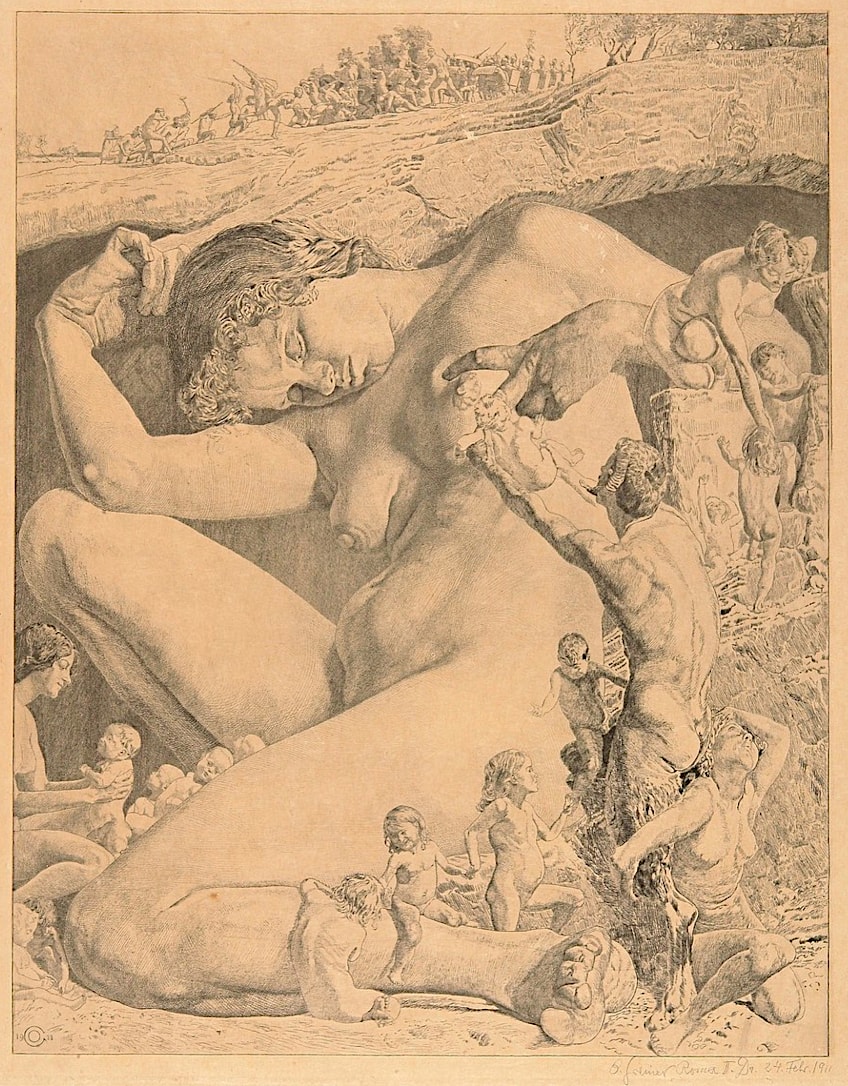 Gäa by Otto Greiner (1912); Otto Greiner, Public domain, via Wikimedia Commons
Gäa by Otto Greiner (1912); Otto Greiner, Public domain, via Wikimedia Commons
Symbols
The Earth is the most fundamental emblem of Gaia. Gaia’s connection to fertility and plenty is frequently represented through the symbolism of fruits, grains, and abundant harvests. She may be illustrated holding or surrounded by ripe fruits like grapes or pomegranates, which symbolize the Earth’s power to supply food. Gaia’s intimate relationship with nature is frequently portrayed in her depictions through her incorporation of animals and wildlife.
She may be surrounded by animals such as rabbits, deer, birds, or snakes, which represent the diversity and interconnection of the natural world.
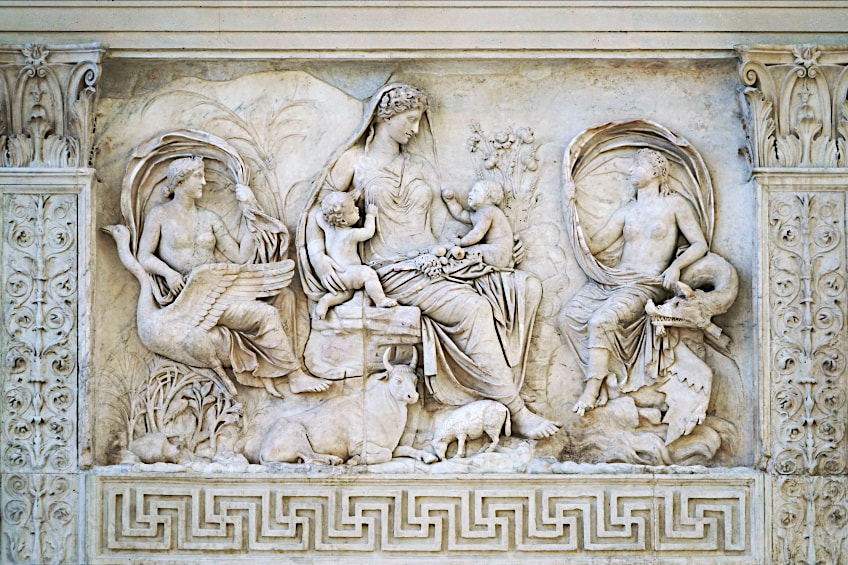 Relief showing the Roman version of Gaia, the Earth Goddess Tellus on the Ara Pacis in Rome (9 BCE); Jean-Pierre Dalbéra from Paris, France, CC BY 2.0, via Wikimedia Commons
Relief showing the Roman version of Gaia, the Earth Goddess Tellus on the Ara Pacis in Rome (9 BCE); Jean-Pierre Dalbéra from Paris, France, CC BY 2.0, via Wikimedia Commons
Flowers and plants are another sign linked with Gaia, reflecting the Earth’s flora and its function in the life cycle. She may be dressed with flower garlands, or wreaths, or shown among fields of blossoming flowers, all of which represent the splendor and energy of the natural world.
Mountains and caverns are often used to depict Gaia’s relationship with the Earth’s physical characteristics.
Mountains signify her power and stability, while caves depict the Earth’s depths and secrets. These symbols emphasize Gaia’s position as the world’s foundation and support. Snakes are often connected with Gaia, representing regeneration, knowledge, and metamorphosis. They depict the life cycle by shedding their skin as a symbol of regeneration and rebirth. Trees and their roots also represent Gaia’s link to the Earth. Trees represent the link between heaven and Earth, while roots represent her anchored energy and deep connections to the soil.
Gaia’s Domains
The Earth is Gaia’s most important domain. She represents the Earth’s physical body and geological elements. Gaia’s dominion comprises all terrestrial habitats, including the valleys and plains. Nature and animals are included under Gaia’s dominion, and she is associated with all the Earth’s flora and fauna. She is intimately linked to fertility and agriculture.
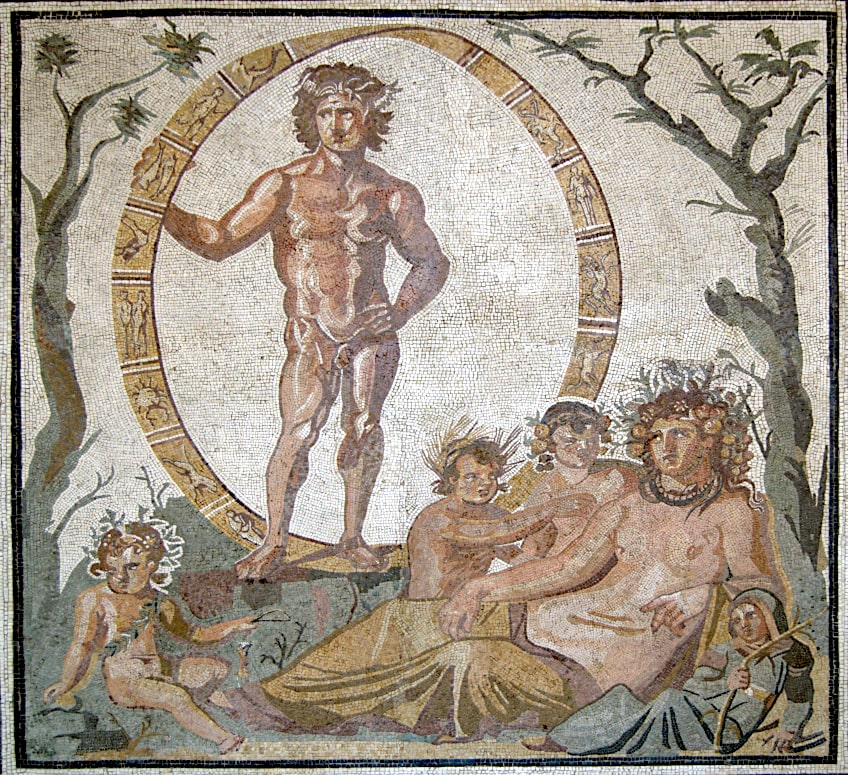 Detail from a mosaic depicting Gaia and the four seasons with Aion (perpetual time) standing in the Zodiac (c. 200-250 CE); Glyptothek, Public domain, via Wikimedia Commons
Detail from a mosaic depicting Gaia and the four seasons with Aion (perpetual time) standing in the Zodiac (c. 200-250 CE); Glyptothek, Public domain, via Wikimedia Commons
Her dominion includes the seasons’ cycles and the Earth’s inherent rhythms. She is in charge of the life-death cycle, and the rebirth of nature.
The impact of Gaia may be seen in the cyclical cycles of growth, destruction, and regeneration. Gaia’s jurisdiction encompasses knowledge and Earth stewardship. She represents knowledge and comprehension of the natural world, encouraging appropriate consideration and reverence for the Earth’s resources. Gaia’s association with the cycle of life also has darker implications. She may the the womb of all mortal things, but she is also their all-consuming grave.
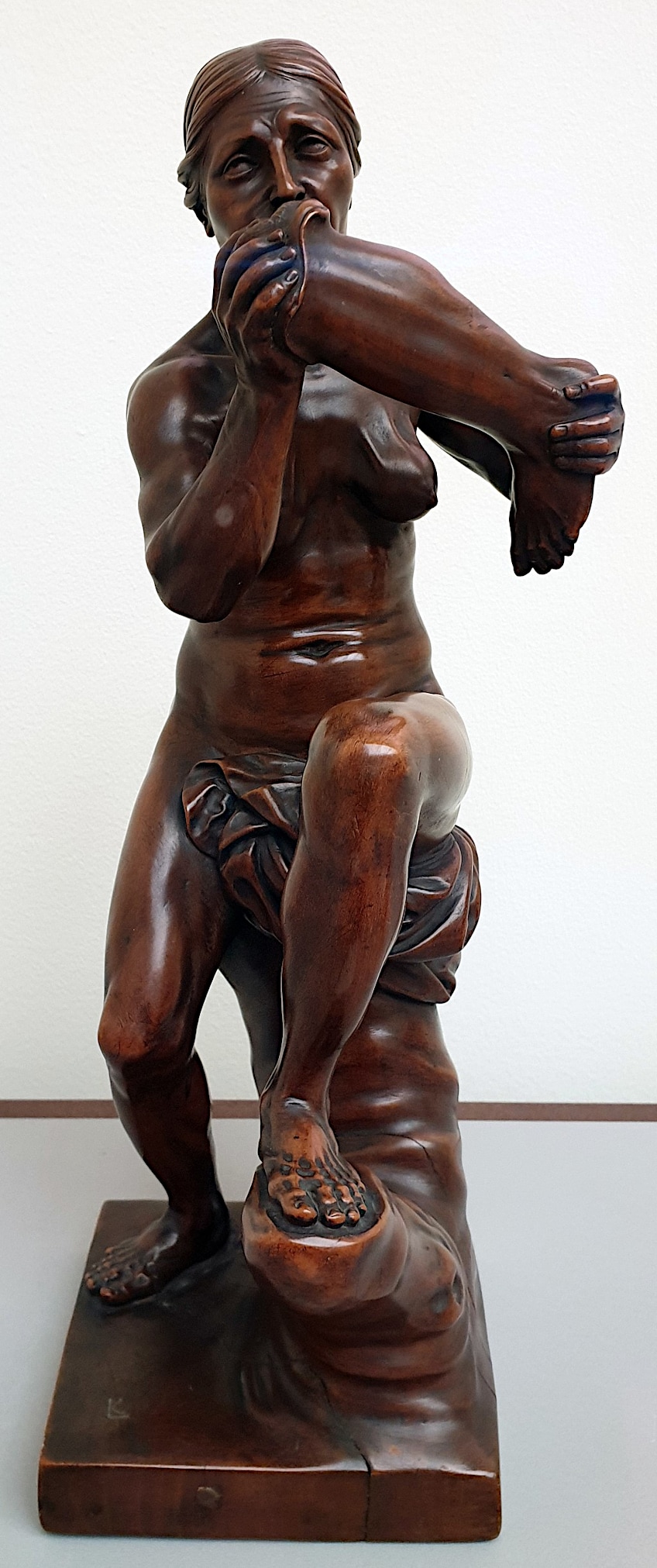 Sculpture of Gaia devouring a human leg by an unknown artist (mid-17th Century); Anagoria, CC BY 3.0, via Wikimedia Commons
Sculpture of Gaia devouring a human leg by an unknown artist (mid-17th Century); Anagoria, CC BY 3.0, via Wikimedia Commons
Gaia Mythology
As a primordial deity, Gaia was a very influential and ancient force in Greek mythology. Therefore, many of the older myths feature her influence. Let’s take a look at some of the most significant stories in Gaia mythology.
Gaia and Uranus
Gaia produced her male counterpart, Uranus, shortly after she was formed, who covered her and aided her in filling the globe. Gaia created the sea (Pontus), the mountains (Ourea), and the first creatures to inhabit the land she created and embodied. Gaia had numerous offspring with Uranus. However, Uranus was a ruthless and envious god.
Uranus pushed his children back into Gaia shortly after they were born, fearing that they might overthrow him and take his position as king of the skies.
Gaia crafted a sickle from gray flint and advised her children to rebel against Uranus and castrate him using the sickle. Cronus was the only one who followed his mother’s orders. He took up the sickle and cut his father’s genitals before throwing them into the water. As he did so, a plethora of beings arose from them, including nymphs, giants, and the lovely Aphrodite.
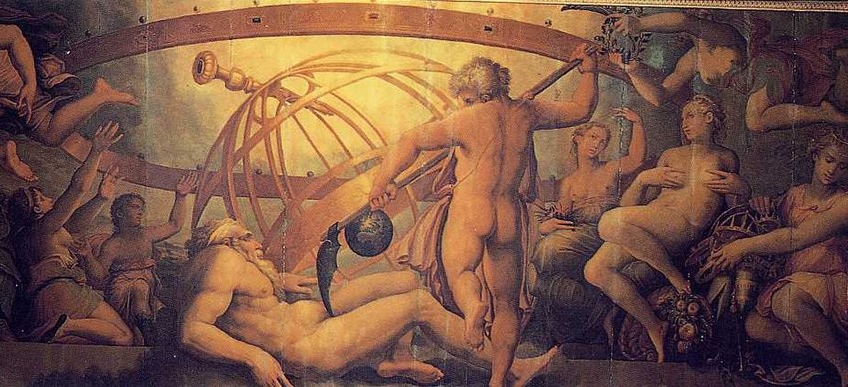 The Mutilation of Uranus by Saturn (Cronus) by Giorgio Vasari and Cristoforo Gherardi (16th Century); Giorgio Vasari, Public domain, via Wikimedia Commons
The Mutilation of Uranus by Saturn (Cronus) by Giorgio Vasari and Cristoforo Gherardi (16th Century); Giorgio Vasari, Public domain, via Wikimedia Commons
Gaia and Zeus
Cronus turned into a tyrant over time. He, like his father preceding him, became apprehensive that the offspring he had conceived with his sister Rhea was going to eventually rise up and topple him. Cronus consumed his first five offspring, Hera, Demeter, Hades, Hestia, and Poseidon, as soon as they were born to prevent this from occurring. Rhea, though, managed to hide her last child, Zeus, in a remote cave and gave Cronus a large stone wrapped in swaddling cloth to swallow instead.
Zeus was reared by his grandmother, the Greek goddess Gaia. The mother goddess trained the next king of the gods well, and he went on to take out his father and establish the rule of the Olympian gods.
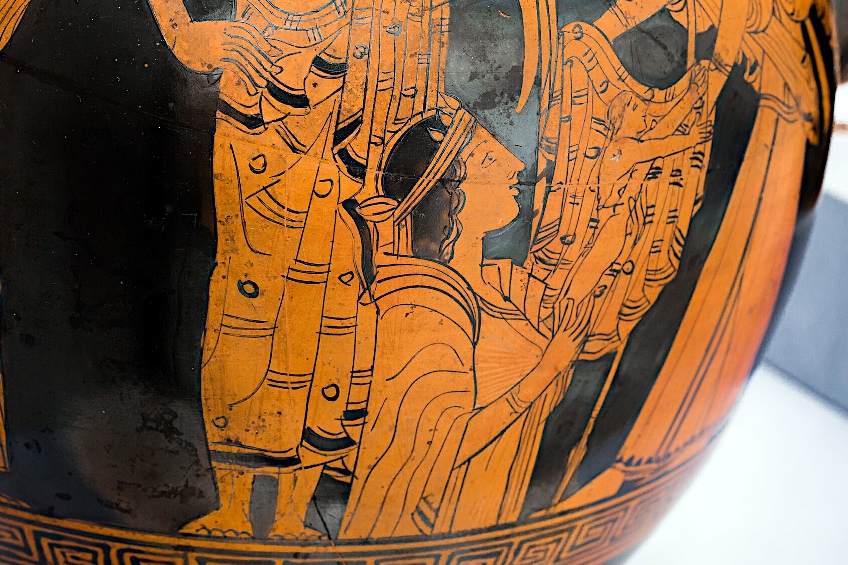 Red-figure hydria depicting Gaia handing a divine infant to a goddess (c. 470-460 BCE); ArchaiOptix, CC BY-SA 4.0, via Wikimedia Commons
Red-figure hydria depicting Gaia handing a divine infant to a goddess (c. 470-460 BCE); ArchaiOptix, CC BY-SA 4.0, via Wikimedia Commons
Gaia and the Olympian Gods
It didn’t take long for the Greek goddess Gaia to turn against the king of the gods, Zeus, just as she had Cronus and Uranus before him. In some accounts, Zeus had imprisoned her children the Titans in Tartarus, and defeated the Giants she sent to punish him. The Giants were either Uranus’ or Tartarus’ offspring with Gaia. They were incredibly powerful and haughty and were sometimes illustrated with serpentine traits like scaly feet or snake hair.
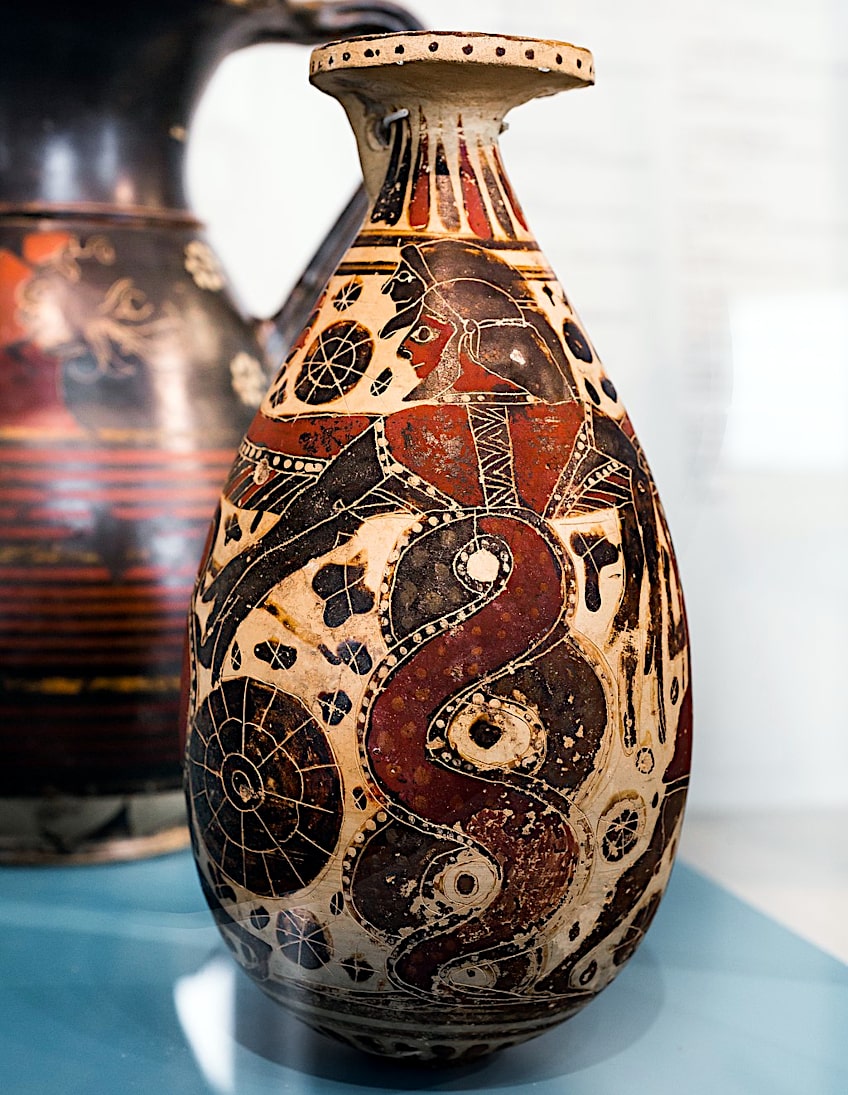 Corinthian black-figure alabastron showing Typhon (c. 600-580 BCE); ArchaiOptix, CC BY-SA 4.0, via Wikimedia Commons
Corinthian black-figure alabastron showing Typhon (c. 600-580 BCE); ArchaiOptix, CC BY-SA 4.0, via Wikimedia Commons
The Gigantomachy was the name given to the conflict between the Giants and the Olympians. It often got confused with the Titanomachy, which was fought between the Titans and the Olympians in antiquity. There are few old texts that chronicle the conflict in detail, but the gods learned of a prophecy that indicated that the Giants could only be overcome with the help of a specific mortal. As a result, the Olympians enlisted Heracles, the most powerful of all mortal heroes, to battle alongside them. Finally, the Giants were defeated, foiling Gaia’s schemes against the Olympians once more.
Gaia’s final onslaught against the Olympians came in the form of Typhon, a monstrous and terrible creature, half man, half animal that stood taller than the mountains and had 100 dragon’s heads. He very nearly destroyed the Olympians, but was eventually defeated by Zeus and buried beneath Mount Etna.
Gaia and Other Offspring
Gaia was also considered to be the mother of Orion, a Giant, and legendary hunter. In most tales, Artemis murdered Orion after he displeased her in some way. Other stories claim that he was murdered by Gaia herself, who sent a big scorpion to slaughter him because she was afraid that the ravenous Orion was going to track down and kill all the creatures on Earth.
Gaia’s offspring were often reliant upon her for their strength.
The Giants Antaeus and Alkyoneus were both indestructible as long as they were in contact with the soil. Herakles lifted Antaeus from the ground to snap his spine, while during the Gigantomachy Athena defeated Alkyoneus by pulling him away from his mother.
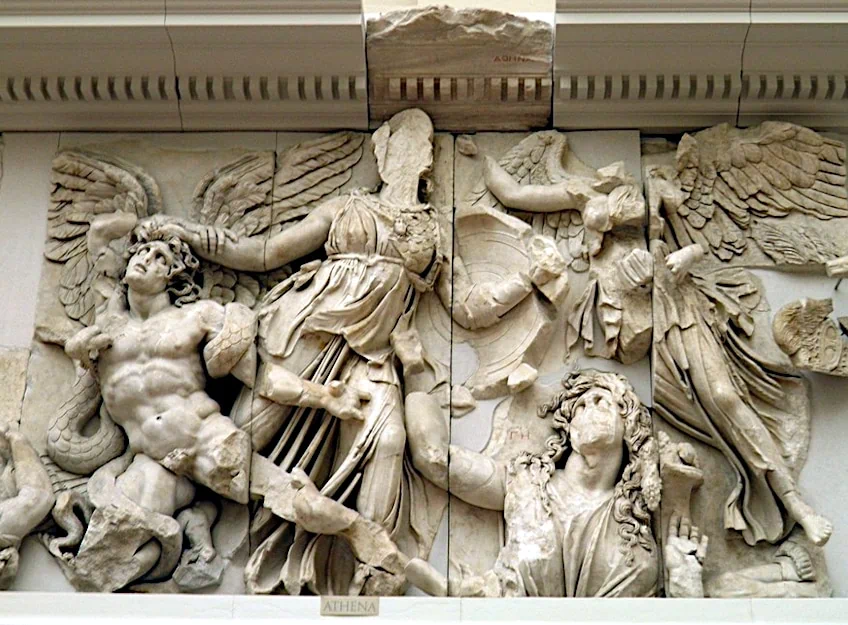 Detail from the east frieze of the great Altar of Pergamon showing Gaia pleading with Athena to spare her son the Giant Alkyoneus (2nd Century BCE); Carole Raddato from FRANKFURT, Germany, CC BY-SA 2.0, via Wikimedia Commons
Detail from the east frieze of the great Altar of Pergamon showing Gaia pleading with Athena to spare her son the Giant Alkyoneus (2nd Century BCE); Carole Raddato from FRANKFURT, Germany, CC BY-SA 2.0, via Wikimedia Commons
Gaia was also a part of Aristaeus’ mythology, an agricultural god who was strongly tied to beekeeping. Aristaeus was often thought to be the son of the nymph Cyrene and Apollo, although, in some accounts, his parents were Gaia and Uranus. The Greek goddess Gaia, according to Pindar, nursed the baby Aristaeus and turned into an immortal.
In several stories, Gaia’s fertility is so strong that she became pregnant after a deity spilled his seed on the ground. Thus, Gaia was supposed to be the mother of the Meliae, Erinyes, and Giants, who emerged from the blood that fell to the ground after Cronus castrated Uranus.
Erichthonius, one of Athens’ founding monarchs, is perhaps the most renowned example of this type of story. In this origin myth the craftsman god Hephaestus fell in love with Athena and attempted to rape her. The specifics alter from one account to another, but in each, Athena quickly escaped and Hephaestus wound up ejaculating on the surface of the earth. Gaia then fell pregnant and gave birth to Erichthonius, who was raised by Athena and later became King of Athens.
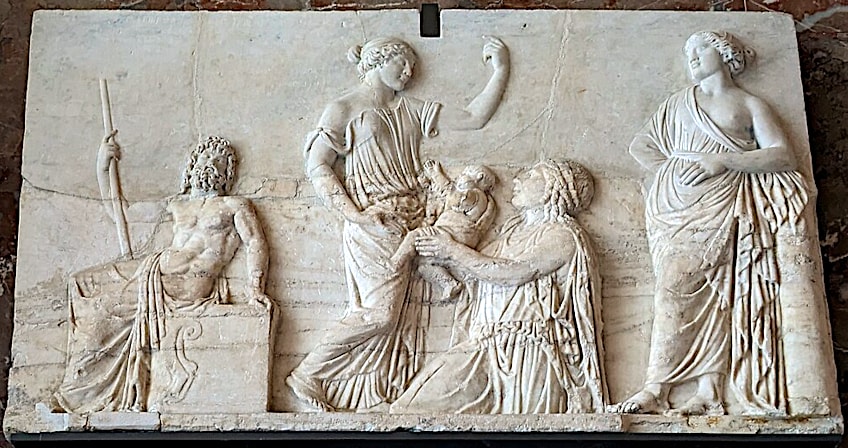 Relief showing Gaia rising from below to hand the newborn Erichthonios to Athena (between 100 and 150 CE); Louvre Museum, CC0, via Wikimedia Commons
Relief showing Gaia rising from below to hand the newborn Erichthonios to Athena (between 100 and 150 CE); Louvre Museum, CC0, via Wikimedia Commons
As a result of this myth, the inhabitants of Athens always purported to be “autochthonous” – that is, to have sprung from the soil itself. This myth was used to justify an Athenian law stipulating that only those born to Athenian parents could claim full citizenship.
In another little-known myth, Elaea, who was a skilled athlete from Attica, was murdered by her fellow athletes because they became envious of her and her abilities. Gaia changed her into an olive tree as a recompense for Athena’s sake. When impious people slaughtered the young Libanus, Gaia transformed him into rosemary.
Gaia and Python
Python was a huge snake created by the coupling of Gaia, the Earth goddess, and Pontus, the primordial sea deity. Python was described as a gigantic snake, sometimes represented as a terrifying creature with numerous heads and a serpentine body. Python’s was Gaia’s guardian of her oracle at the sacred site of Delphi, which was situated at the foot of Mount Parnassus.
Python had been instructed by Hera to prevent Leto from giving birth. In revenge Apollo fought the serpent fiercely and ultimately prevailed, executing Python with his arrows. Apollo then seized control of the oracle. His priestess who would pronounce his oracles was called the Pythia, retaining the Delphic connection to its original guardian.
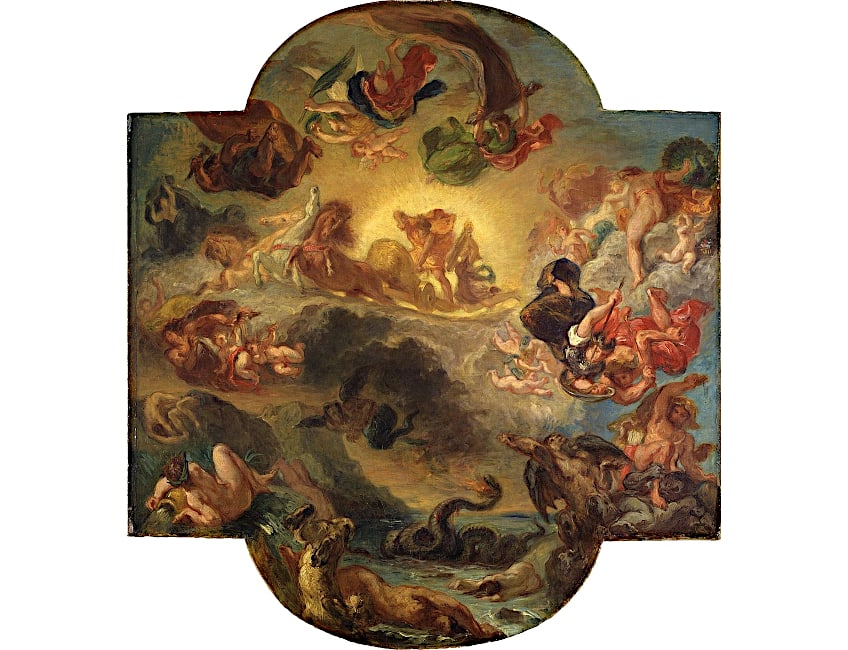 Apollo Slays Python by Eugène Delacroix (c. 1853); Eugène Delacroix, CC BY-SA 4.0, via Wikimedia Commons
Apollo Slays Python by Eugène Delacroix (c. 1853); Eugène Delacroix, CC BY-SA 4.0, via Wikimedia Commons
Python’s narrative and its relationship to Gaia highlight the importance of the Oracle of Delphi for the ancient Greeks. It implies that the skill of divination and prophecy was firmly embedded in the Earth and related to the primeval energies represented by Gaia. This story also emphasizes the interaction of several deities and the battles for dominance throughout Greek mythology.
Gaia in Modern Ecological Theory
James Lovelock reintroduced the legendary term in Gaia: A New Look at Life on Earth in 1979. The theory suggests that living creatures and inorganic matter are components of a dynamical system that forms the Earth’s biosphere and keeps the planet alive.
The Earth is seen as a “superorganism” capable of self-regulation.
Lovelock’s and others’ subsequent writings promoted the Gaia Hypothesis, which was originally accepted by New Age activists in the 1970s as part of an increased understanding of environmental problems.
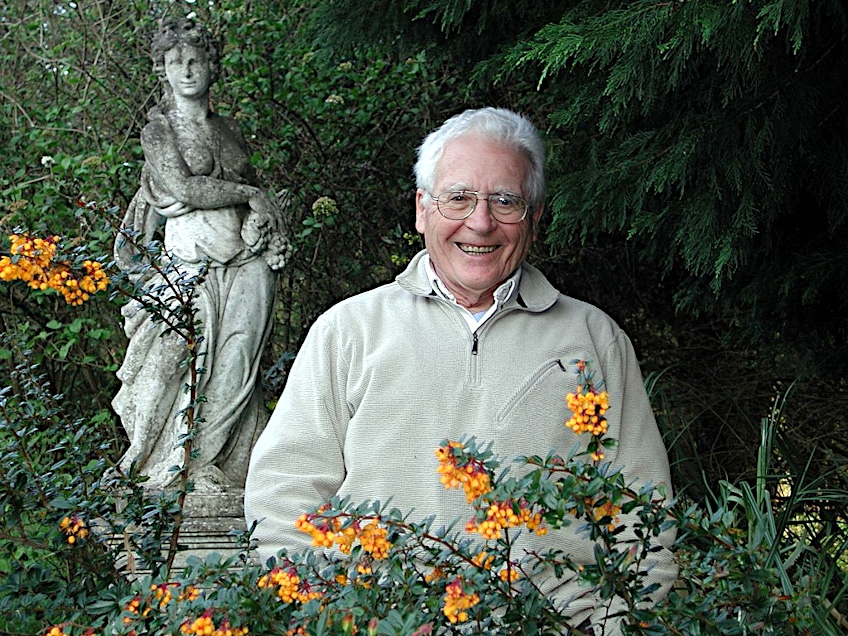 Photograph of the author and scientist known for the Gaia Hypothesis James Lovelock taken in 2005; The original uploader was Bruno Comby at English Wikipedia., CC BY-SA 1.0, via Wikimedia Commons
Photograph of the author and scientist known for the Gaia Hypothesis James Lovelock taken in 2005; The original uploader was Bruno Comby at English Wikipedia., CC BY-SA 1.0, via Wikimedia Commons
In the decades since, ecologists and Lovelock have proven and continue to find in ever-increasing detail that the ocean salinity, the atmospheric concentration of O2, and a variety of other Earth characteristics are self-regulated in closely linked processes that involve air, rocks, water, and living organisms.
Gaia in Neopaganism and Wicca
Gaia is worshiped as a divinity connected with the natural world in Neopaganism and Wicca. While practices and beliefs differ amongst people and traditions within various spiritual pathways, Gaia is often depicted as a major figure symbolizing the divine feminine and signifying the interdependence of all life. Wicca and Neopaganism stress an earth-centered spirituality that recognizes the holiness of nature and the Earth.
In this setting, Gaia is seen as a primary divinity, symbolizing the living Earth and the divine energy within it. Gaia’s adherents venerate natural holy locations. Believers perform rituals to get in touch with Gaia’s energy and show their gratitude for the riches of the Earth.
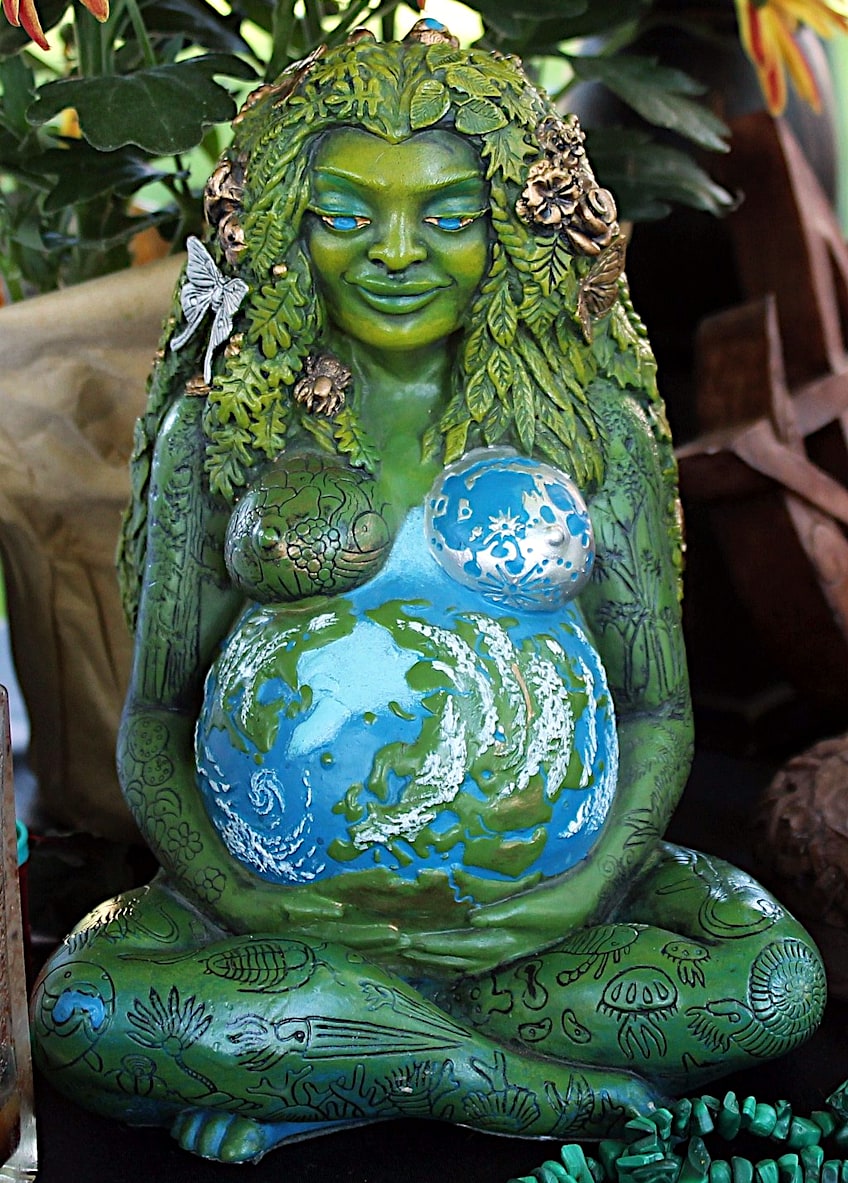 Modern Wiccan/Neopagan Mother Earth figurine; Amber Avalona, CC0, via Wikimedia Commons
Modern Wiccan/Neopagan Mother Earth figurine; Amber Avalona, CC0, via Wikimedia Commons
Neopagan and Wiccan spiritual activities revolve around nature worship and ecological awareness. The adoration of Gaia in Neopaganism and Wicca is also often associated with activism for the environment and ecological stewardship. Many practitioners see themselves as Earth stewards, seeking to safeguard and repair the natural environment in the spirit of Gaia, who represents the Earth’s connection and balance. Herbs, flowers, fruits, or libations may be offered as gestures of reverence.
These rituals usually focus on cultivating a strong spiritual connection with the natural world and asking Gaia for guidance and blessings.
The Greek Goddess Gaia Through the Ages
Greek mythology, especially the worship of Gaia, inspired Roman religious concepts as the Roman Empire expanded. Gaia became Terra Mater, the Roman goddess of the Earth, after being absorbed into the Roman pantheon. She kept many of her Greek mythological characteristics and affiliations.
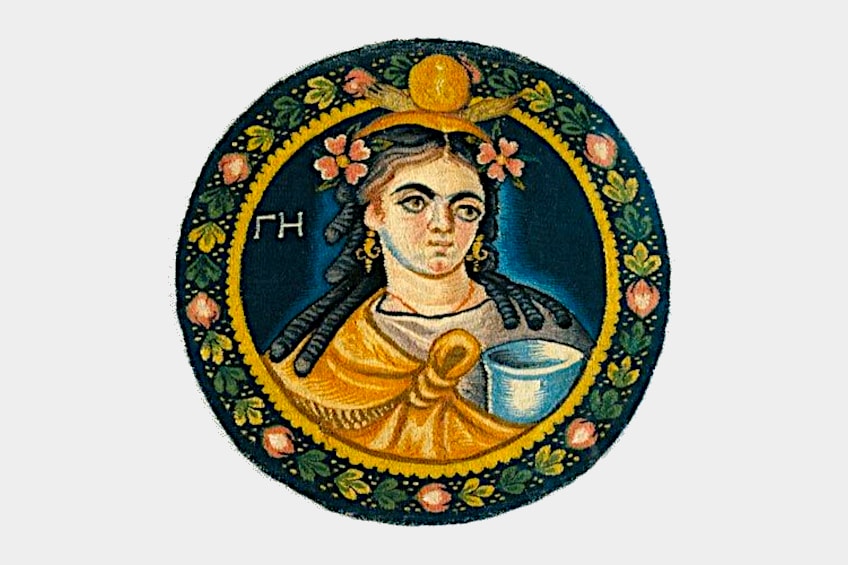 Egyptian Coptic textile depicting Gaia-Isis in a medallion (4th Century CE); See page for author, Public domain, via Wikimedia Commons
Egyptian Coptic textile depicting Gaia-Isis in a medallion (4th Century CE); See page for author, Public domain, via Wikimedia Commons
There was a revival of interest in Greek mythology, particularly Gaia, during the Renaissance. Artists and intellectuals were inspired by Greek and Roman mythology, and Gaia’s image in art and literature remained essentially a mother and caring deity related to the Earth.
The name “Gaia” experienced a comeback in a scientific and ecological context in the late 20th century. As we mentioned earlier, this theory is based on the concept of Gaia as a living, interconnected organism.
The Lessons of the Greek Goddess of the Earth
Gaia personifies interconnectivity and the rich tapestry of relationships that exists in the natural world. Her story is a reminder that everything is interrelated and that choices have repercussions for the environment. It inspires stewardship and mindfulness in how humanity relates to the Earth and all living things. Gaia’s mythology emphasizes the sanctity of nature and the Earth.
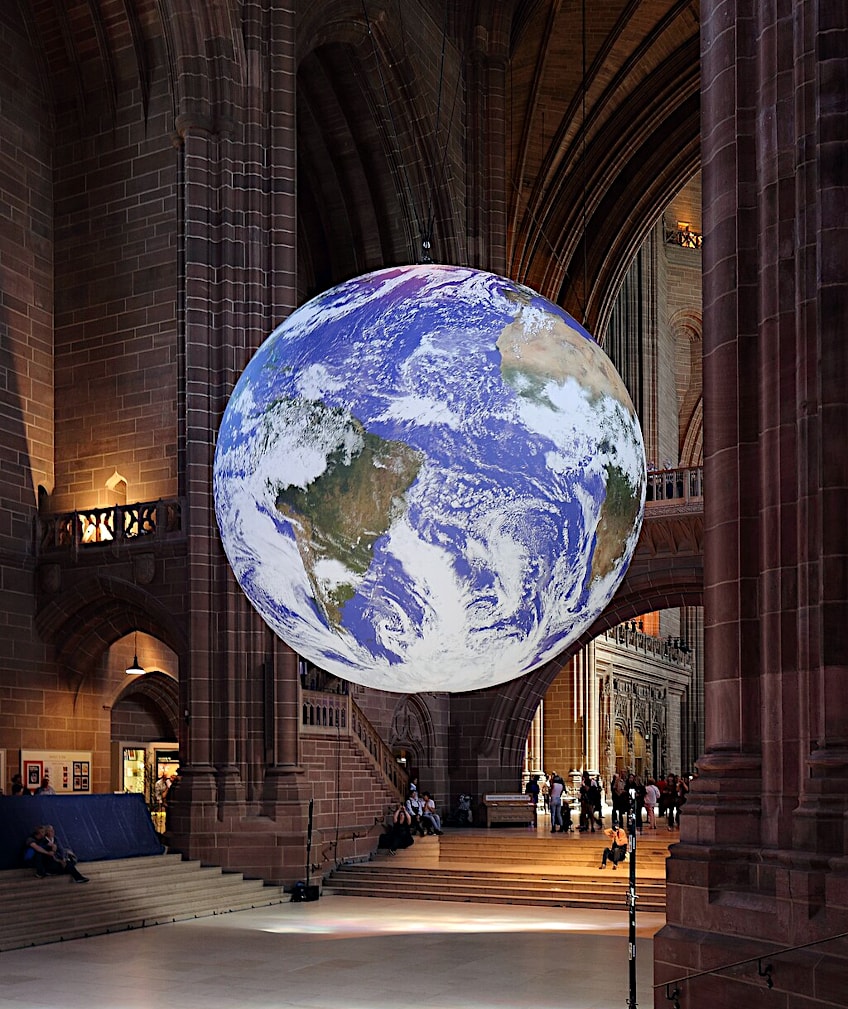 Gaia installation in Liverpool Cathedral by Luke Jerram (2019); By Phil Nash from Wikimedia Commons CC BY-SA 4.0, CC BY-SA 4.0, via Wikimedia Commons
Gaia installation in Liverpool Cathedral by Luke Jerram (2019); By Phil Nash from Wikimedia Commons CC BY-SA 4.0, CC BY-SA 4.0, via Wikimedia Commons
The myth of Gaia serves as a reminder to cultivate a genuine regard for the natural world and to realize its intrinsic value. Gaia is a modern metaphor for an understanding that ecosystems thrive when diverse constituents are in a careful balance. Just as Gaia keeps the Earth’s systems in balance, humans thrive when achieving balanced interactions with people and the environment.
In Greek mythology, Gaia is a primordial deity and the embodiment of the Earth. Gaia came from Chaos and is revered by immortals and humans alike as the ultimate mother goddess. Through her coupling with Uranus and Pontus, all the other gods and goddesses are descended from her. The Greek goddess Gaia was the Oracle of Delphi’s first overseer, and she often cautioned others about prophecies she had received. Her influence is still felt today in modern ecological movements and Neopagan religious practices.
Frequently Asked Questions
Is Gaia a Titan?
No, the Greek goddess Gaia is not a Titan. The Titans were the children of Gaia and her consort Uranus who rebelled against their father’s rule at Gaia’s request and with her assistance. Gaia is actually regarded as one of the first primordial deities and the personification of the Earth itself.
What Is Gaia the God Of?
Gaia is considered to be the ancient Greek goddess of Earth. The Earth is not only her domain, she is the embodiment of it. As the Greek goddess of the Earth, she was the mother of the first gods and ancestor to all divine beings in the Greek cosmology. in modern usage, Gaia is the metaphorical custodian of everything that dwells upon the Earth’s surface and oceans, from the peaks and valleys, to all the animals and flora.

I am deeply passionate about history and am constantly fascinated by the rich and complex stories of the past. As the editor-in-chief of learning-history.com, I have the opportunity to share this passion with a wide audience through the creation and distribution of engaging and informative content about historical events, persons, and cultures. Whether it’s through writing articles and blog posts or creating videos or podcasts, I strive to bring the past to life in a way that is both accurate and enjoyable. My expertise in history, combined with my strong writing and communication skills, allows me to effectively communicate complex historical concepts and make them accessible and interesting to a wide range of readers. I am truly grateful for the opportunity to share my love of history with others through my work on learning-history.com.


